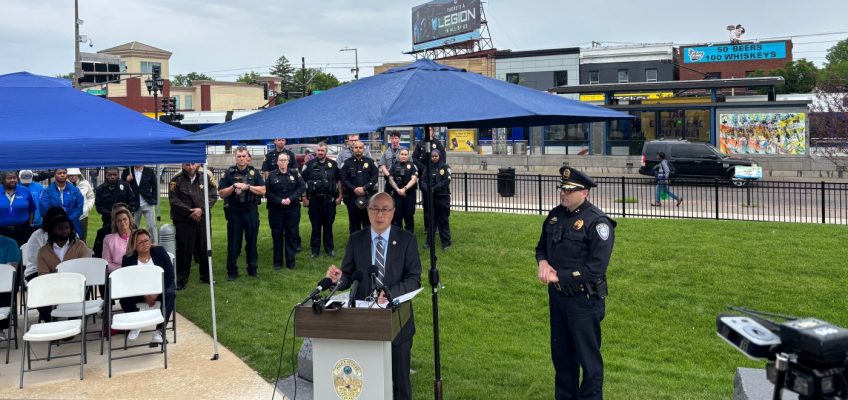Law enforcement will have a more visible presence along St. Paul’s University Avenue and the Green Line, and service providers will be guiding people to resources including addiction treatment and housing services, Metro Transit police announced Wednesday.
A new initiative, Safe and Strong University Avenue, will bring together law enforcement, service providers and prosecutors. It’s planned to last until at least the end of summer and may be extended.
Metro Transit police, St. Paul police and the Ramsey County sheriff’s office “will conduct high visibility, coordinated enforcement operations on the Green Line corridor based on precise data … from our crime intelligence team,” said Joe Dotseth, interim Metro Transit police chief, at a Wednesday press conference near University and Snelling avenues.
Metro Transit is “developing dedicated police beats in this area, a proven approach that reduces crime and builds public trust through consistent officer presence,” including a Hamline-Midway beat, Dotseth added.
They also have the Transit Response Unit, which is out on the system to deal with serious crime.
The most serious crimes were up slightly on the Metro Transit system in the first quarter of this year, compared to last year, but down from two years ago.
In the categories of robbery, assault, homicide, sex offense, theft from person, motor vehicle and burglary, there were 211 reports in the first quarter of this year (there were no homicides), compared with 200 in the same period last year and 291 in the first quarter of 2023, according to Metro Transit statistics.
‘Public health approach’ included in plan
Safe and Strong University Avenue builds on Metro Transit’s ongoing work to expand official presence on transit, which goes beyond police and includes community service officers and TRIP agents (Transit Rider Investment Program), Doseth said.
“This is not solely about enforcement,” he said. “While serious criminal behavior will result in arrest, our collaborative approach prioritizes connecting people with services whenever possible.”
Responders from St. Paul-Ramsey County Public Health are working alongside the Metro Transit’s Homeless Action Team “to bring a public health approach to concerns that arise on public transit,” said Gloria Reyes, deputy Ramsey County manager of the Safety and Justice Service Team.
Public health responders provide Narcan, along with referrals for services. Ramsey County’s mental health response teams are also supporting people “in emotional distress, helping stabilize situations and guiding people to long term care,” Reyes said.
“People who are struggling, people who are causing a disturbance, … there’s law enforcement there, but there’s also an opportunity for us to get to the root causes of what’s occurring on the Metro Green Line,” Reyes said. “… We are seeing a public health crisis, and we need to bring our public health crisis workers out into the field.”
Prosecution approach includes looking at mental health, addiction
Ramsey County Attorney John Choi said they’ve been meeting with Metro Transit police, St. Paul’s police and Office of Neighborhood Safety, along with the Ramsey County sheriff’s office.
“The light rail system truly belongs to the people,” he said. “And we’ve had some challenges over the past few years. We’re starting to see some better outcomes, but we know that we need to do more.”
Since August, the Ramsey County Attorney’s Office has been asking law enforcement agencies that present cases for charging consideration to designate which ones happened in the University Avenue/Green Line corridor. There have been 111 cases in the corridor presented since August and the county attorney’s office has charged more than 80 percent of them.
“What we are asking for is better investigation on those cases and more information so that we can take the appropriate steps in the court system,” Choi said.
That’s led to prosecutors asking judges to issue orders to stay away from transit or geographic areas in some instances, and also to efforts to “address the underlying reasons of their justice involvement, which oftentimes is mental health related or addiction related,” he added.
For violent offenses, Choi said his office still seeks prison time or the recommendation under state sentencing guidelines, but many of the cases that emerge from the area are misdemeanor or gross misdemeanor level.
Ridership below pandemic levels
Metro Transit ridership has been increasing, though it still remains below pre-pandemic numbers. There were 47.6 million rides on the system last year, compared with 77.9 million in 2019, according to Metro Transit data.
Related Articles
Bayport couple found dead in home; natural causes determined
Group calls for Target to apologize, St. Paul PD to look at false reporting after 2 men accused of being armed
Wildfire evacuation orders lifted in northern Minnesota
What Minnesota laws and policies changed after George Floyd? Here are 9 topics
‘100 deadliest days’ on roads kick off Memorial Day weekend
In the first quarter of 2025, proactive calls for police service by Metro Transit officers increased 55% compared to the same quarter last year.
“We’re aggressively targeting quality-of-life violations that diminish the riders’ experience,” Doseth said, which could include smoking on the train or people acting in a disorderly way. “Serious crimes on the system remain consistently low.”
In a fall survey, more than 40% of respondents said the system felt safer than it did six months ago, in part due to increased presence, Metro Transit said.


Leave a Reply